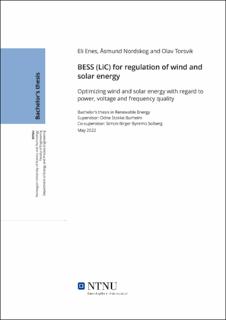| dc.contributor.advisor | Burheim, Odne | |
| dc.contributor.advisor | Solberg, Simon | |
| dc.contributor.author | Enes, Eli | |
| dc.contributor.author | Nordskog, Åsmund | |
| dc.contributor.author | Torsvik, Olav | |
| dc.date.accessioned | 2022-07-05T17:22:56Z | |
| dc.date.available | 2022-07-05T17:22:56Z | |
| dc.date.issued | 2022 | |
| dc.identifier | no.ntnu:inspera:110285048:113534711 | |
| dc.identifier.uri | https://hdl.handle.net/11250/3002947 | |
| dc.description.abstract | Sammendrag
På grunn av den økte implementeringen av fornybare energikilder i nettet, er det et klart behov for en teknologi som kan håndtere de assosierte effekt-svingningene. Beyonder har utviklet en høyeffekt lithium-ione kondensator som er produsert på en bærekraftig måte. Ettersom introduksjonen av storskala uregulerbare fornybare energikilder i nettet øker, kan de tilhørende effektsvingningene føre til spenning,- og frekvensavvik. Slike avvik kan ha betydelige innvirkninger på kraftsystemer og leveringssikkerheten.
Tre casestudier ble laget for å undersøke LiCens evne til å forbedre effektkvaliteten assosiert med produksjonen fra vind- og solenergi. Et system, konstruert av flere LiC-celler koblet sammen i serie og paralell, ble forsøkt implementert i en fullskala vind og solpark, i tillegg til en solpark som allerede inneholdt en LiB brukt til energiskifting. For å utføre simuleringer av de ulike systemene ble programvaren Simulink brukt. De simulerte systemene ble bygd opp av konstruksjoner av en LiC og en LiB, input signaler med høy oppløsning, batteri kontrollerer og syklustellerer. Kapasiteten til LiC-systemet for de ulike applikasjonene ble bestemt ut ifra faktorer som blandt annet energibehov, C-rate og levetid.
Alt i alt hadde implementeringen av LiCen en positiv effekt i vind,- og solparken. Resultatene viste at en forbedring i effekt,- spenning- og frekvenskvalitet kunne oppnås om LiCen ble dimensjonert og kontrollert på riktig måte. I disse to casene viste resultatene at investeringen kunne rettferdiggjøres. Implementeringen førte til et bedre energiforbruk og tilrettela for større implementering av fornybare energikilder i nettet. Med tanke på energiskifting senarioet var det usikkert om resultatene fra implementeringen av LiC var tilstrekkelige med tanke på investeringskostnaden, selv om LiB levetiden ble forbedret grunnet en mer hensiktsmessig ladingskarakterestikk. På den andre siden pekte resultatene fra de to andre casene på at investeringen var økonomisk bærekraftig, med en investeringskostad på kun 0.7% sammenlignet med en hel vindpark. I tillegg er Beyonder sin LiC bærekraftig med tanke på at den pro duseres av økologiske materialer og at produksjonen skjer i Norge hvor vannkraft er dominerende. | |
| dc.description.abstract | Abstract
With the increasing implementation of renewable energy sources in the grid, there is a clear need for a technology capable of handling the rapid power variations associated with these. Beyonder has developed a new high power lithium-ion capacitor produced in a sustainable manner. As the introduction of large scale intermittent renewable energy sources increases, the belonging power fluctuations can result in voltage and frequency deviations. Such deviations can have a severe impact on the power system and the security of delivery.
In order to investigate the lithium-ion capacitor, or LiC’s, ability to improve the power quality associated with production from wind and solar power, three case studies were built. A system, consisting of several LiC cells connected in series and parallel, was tried imple mented in a full scale wind power plant, a solar power plant, and in a solar power plant already containing a lithium-ion battery (LiB) used for energy shifting. In order to perform simulations of these systems, the software Simulink was used. The simulated systems was built up of constructions of a LiC and LiB, high resolution input signals, battery energy storage system (BESS) controllers and cycle counters. The capacity of the LiC for the different applications was determined by factors such as the energy demand, C-rate and the cycle life time.
All things considered the LiC had a beneficial impact on the wind and solar power cases. The results showed that if dimensioned and controlled properly, an improved power, voltage and frequency quality could be obtained. In these two cases it was found that the added benefits justified the investment cost. The implementation led to an improved utilization of the energy which furthermore led to the possibility of increased penetration of intermittent renewable energy systems, IRES. When assessing the integration of LiC in an energy shifting scenario, it was not evident that the beneficial impact would outweigh the investment cost. Even though the implementation contributed to a longer LiB lifetime, by presenting a more beneficial charge and discharge characteristic. However, the economical results from the two prior case studies pointed to the fact the the LiC technology is economically sustainable, with an investment cost corresponding to only 0.7% of that of a wind power plant. Additionally Beyonder’s LiC has a low footprint considering that it is made using ecological materials and have a material production supported by a Norwegian power mix. | |
| dc.language | eng | |
| dc.publisher | NTNU | |
| dc.title | BESS (LiC) for regulation of wind and solar energy | |
| dc.type | Bachelor thesis | |
